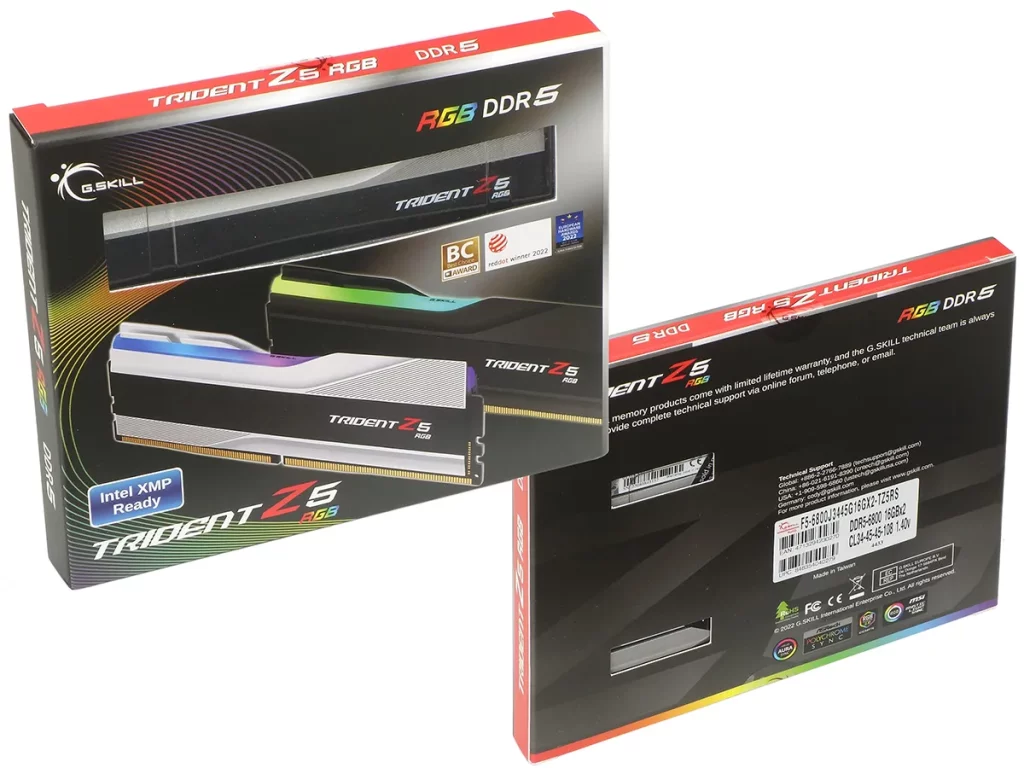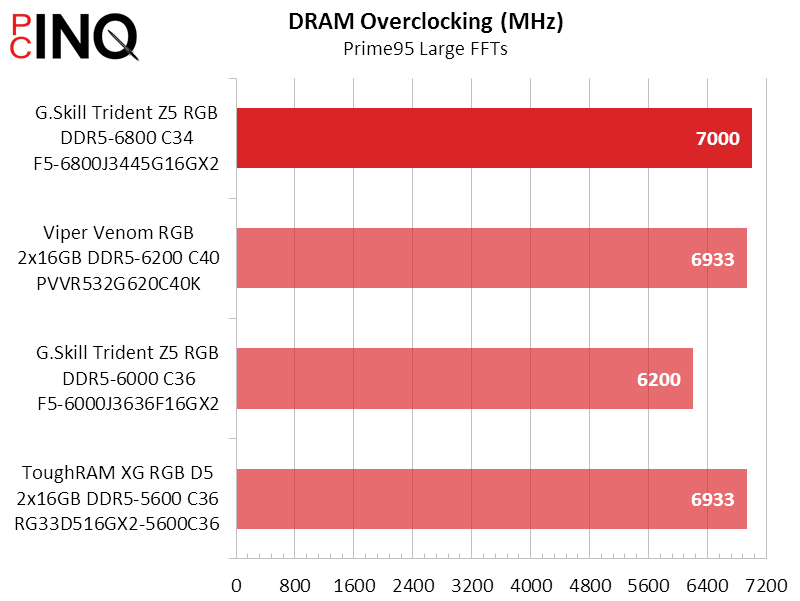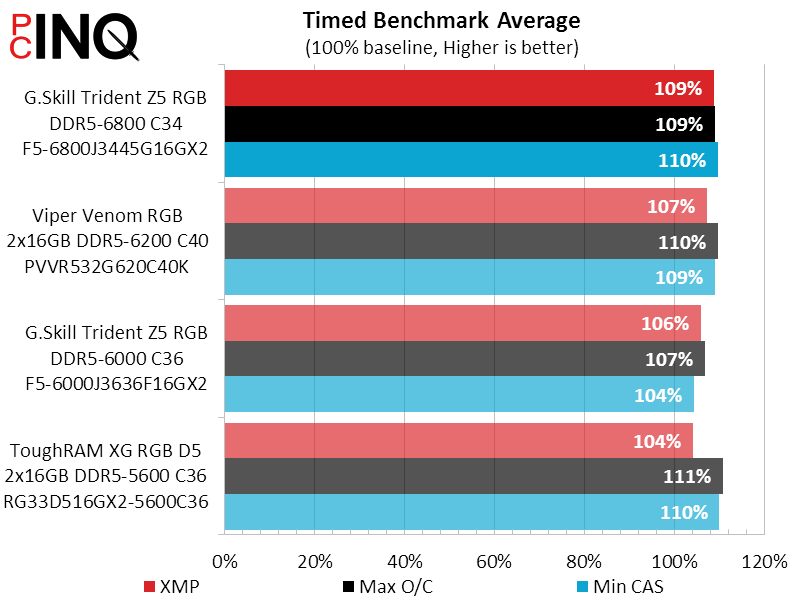G.Skill Trident Z5 6800 C34 RGB Review: Freakish Performance
Every Trident Z5 RGB module is lighted, but this is the first kit we’ve seen from G.Skill in quite some time to qualify for multiple definitions of the word lit: Specifically, its CAS 34 timings make it one of the first DDR5 kits that we’ve tested to qualify as “low latency” in the classical sense of having only one cycle of latency for every 100 cycles of clock frequency. To top that off, it also has an XMP data rate that exceeds our DDR5-6400 high standard.
| G.Skill Trident Z5 RGB model F5-6800J3445G16GX2-TZ5RS | |||
| Capacity | 32 GB (2x 16GB) | Voltage | 1.40 Volts |
| Data Rate | DDR5-6800 (XMP) | Height | 44mm |
| Primary Timings | 34-45-45-108 (2T) | Warranty | Lifetime |
Get it at Amazon

(click for availability)
CAS 34 certainly doesn’t define this kit’s entire timing set, and the Trident Z5 RGB we’re testing today has lazier 45-cycle tRCD and tRP. These three timings are generally listed in order of importance, so that CAS 34-45-45 is still likely to perform better than, say, CAS 40-40-40.

Windowed on both sides to expose each module’s serial number, the retail box contains two modules, a case badge and a relatively generic information card. Lighting control is supported through most third-party RGB utilities, including Asus Aura Sync, Gigabyte RGB Fusion, MSI Mystic Light and ASRock Polychrome Sync.


Our motherboard automatically configured the Trident Z5 6800 CAS 34 kit to standard DDR5-4800 C40 timings before we entered BIOS to enable XMP, thereby enabling its full set of performance enhancements.

Trident Z5 RGB carries G.Skill’s lifetime limited warranty regardless of its rated data rate, though the company doesn’t guarantee that your CPU and motherboard can operate any memory at this data rate. Understanding the limits of your other hardware should be done before ordering high speed memory, to assure that you won’t end up trying to return as defective something that isn’t.
Test Platform Hardware
Our legacy motherboard test platform has been equipped with ASRock’s Z690 Taichi and upgraded to Intel’s Core i9-13900K via a version 13.05 firmware update. Carried forward from our early AM5 platform review, Powercolor’s Red Devil Radeon 6750 XT completes its modernization.
| Test Hardware | |
| CPU | Intel Core i9-13900K: 24C/32T, 3.0-5.8 GHz, 36 MB L3 Cache, LGA 1700 |
| CPU Cooler | Alphacool Eisblock XPX CPU, VPP655 with Eisbecher D5 150mm, NexXxoS UT60 X-Flow |
| Motherboard | ASRock Z690 Taichi LGA 1700, BIOS 13.05 |
| Graphics | Powercolor Red Devil Radeon 6750 XT: 2324-2623MHz GPU, 12GB GDDR6 |
| Power | be quiet! Dark Power Pro 10 850W: ATX12V v2.3, EPS12V, 80 PLUS Platinum |
| Hard Drive | Sabrent Rocket 4 Plus 2TB PCIe 4.0 M.2 SSD |
| Sound | Integrated HD Audio |
| Network | Integrated Wi-Fi |
| Graphics Driver | AMD Adrenalin Edition 2022.10.1 |
We’re dropping the -TZ5RS appearance code from the charts and tables of today’s G.Skill Trident Z5 RGB model F5-6800J3445G16GX2-TZ5RS memory review because its name was simply too long to fit these conveniently, and because the kit is supposed to perform the same way regardless of its heat spreader color or RGB presence.
Overclocking & Latency Tuning
Trident Z5 RGB DDR5-6800 surpasses our current overclocking record by 67 MHz to reach DDR5-7000 at the same CAS 42 and 1.35V previously used in all of our recent memory overclocking endeavors. This is actually a voltage decrease from the kit’s 1.40V XMP: We didn’t feel like retesting all of those at a higher setting, and our reluctance to add days of additional testing to our workload happily coincides with our interest in test consistency.

Latency is opposite of frequency, as faster cycles take less time to complete. So lower is better when it comes to latency, and today’s Trident Z5 is lowest of them all at the tightest DDR5-6400, DDR5-5600, and DDR5-4800 timings we could set without having the memory crash after hours of stability testing.
| Lowest Stable Timings | |||
| DDR5-6400 | DDR5-5600 | DDR5-4800 | |
| G.Skill Trident Z5 RGB F5-6800J3445G16GX2 |
32-38-38-76 (2T) | 28-33-33-66 (2T) | 24-28-28-56 (2T) |
| Viper Venom RGB PVVR532G620C40K |
36-38-38-76 (2T) | 31-33-33-66 (2T) | 26-29-29-58 (2T) |
| G.Skill Trident Z5 RGB F5-6000J3636F16GX2 |
X | 31-31-31-62 (2T) | 28-28-28-56 (2T) |
| ToughRAM XG RGB D5 RG33D516GX2-5600C36 |
36-38-38-76 (2T) | 31-33-33-66 (2T) | 26-28-28-56 (2T) |
Performance Results
The Trident Z5 6800 beats everything in Sandra Bandwidth, even if its winning overclock barely edges out the DDR5-6933 reached by three of its competitors. More importantly, those who don’t use manual timings will notice that the Z5 6800 offers the best XMP-based performance across every memory test.






The Trident Z5 6800’s XMP also pins the needle in both 3DMark and F1 2021 (speedometer references seem appropriate even if F1 cars don’t have these).


Surprisingly, the Z5 6800 XMP does not beat all others in 7-Zip synthetic, which is why we’re happy we also included our legacy real-world test. Our real-world test better reflects the faster kit’s advantage in other metrics, and being a real-world test its numbers are likely more trustworthy.




Our baseline in this case refers to data carried forward from a previous DDR5-4800 kit, and using such an ordinary baseline shows us that even at DDR5-6800, users can expect a performance benefit of less than 10%. The Z5 6800’s XMP still beats that of its closest rival by 2% however.

Being the fastest usually gets a product an award of some kind, and there’s no glaring flaws that we could have used to create an exception here. G.Skill Trident Z5 RGB model F5-6800J3445G16GX2-TZ5RS is the fastest memory we’ve tested, having both the best performing XPM and greatest overclocking ability.
| G.Skill Trident Z5 RGB model F5-6800J3445G16GX2-TZ5RS | |
| Pros | Cons |
|
|
| The Verdict | |
| G.Skill Trident Z5 RGB 6800 has the best XMP and highest manual overclocking ability of any kit we’ve tested. | |

